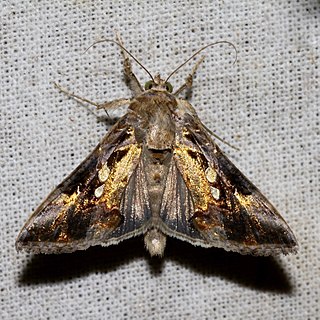
Anax guttatus, the pale-spotted emperor or lesser green emperor, is a dragonfly of the family Aeshnidae.

Sir George Hamilton Kenrick FRES was an English entomologist who specialised in Lepidoptera especially those of New Guinea. He was a prominent liberal educationist and was a councillor in Birmingham.

Ficus obliqua, commonly known as the small-leaved fig, is a tree in the family Moraceae, native to eastern Australia, New Guinea, eastern Indonesia to Sulawesi and islands in the southwestern Pacific Ocean. Previously known for many years as Ficus eugenioides, it is a banyan of the genus Ficus, which contains around 750 species worldwide in warm climates, including the edible fig. Beginning life as a seedling, which grows on other plants (epiphyte) or on rocks (lithophyte), F. obliqua can grow to 60 m (200 ft) high and nearly as wide with a pale grey buttressed trunk, and glossy green leaves.

Utetheisa pulchelloides, the heliotrope moth, is a moth of the family Erebidae. It is found in the Indo-Australian region including Borneo, Hong Kong, New Zealand, Papua, Seychelles, most of Australia,Tenerife and La Línea de la Concepción [Cádiz]. The species was first described by George Hampson in 1907.

Glyphodes is a genus of moths of the family Crambidae described by Achille Guenée in 1854.

Bulbophyllum longiflorum, commonly known as the pale umbrella orchid, is a species of epiphytic or lithophytic orchid. It has a creeping rhizome, widely spaced, dark green pseudobulbs with a single large, fleshy leaf, and flowers spreading in a semicircular umbel, resembling one-half of an umbrella. The flowers are canoe-shaped, greenish cream-coloured to yellowish with purple dots. It has a wide distribution and is found in parts of Africa, on islands in the Indian and Pacific Oceans, Southeast Asia, New Guinea and northern Australia.

Argyrogramma signata, the green semilooper, is a moth of the family Noctuidae.
Trissodoris honorariella, the pandanus leaf perforator or pandanus hole-cutter moth, is a small cosmet moth species. It belongs to subfamily Cosmopteriginae and is the type species of the genus Trissodoris. Baron Thomas Walsingham in 1907 had specimens from both ends of the species' range – New Guinea and Pitcairn Island – which he described as separate species Stagmatophora honorariella and S. quadrifasciata in the same work. But his mistake was soon recognized, and when Edward Meyrick established the genus Trissodoris in 1914, he chose the former name to be valid.

Sameodes cancellalis is a species of moth of the family Crambidae described by Philipp Christoph Zeller in 1852. It has a wide distribution and has been recorded from India, Sri Lanka, Nepal, Myanmar, Thailand, Indochina, Taiwan, Japan, China, Indonesia, Malaysia, the Philippines, New Guinea, western and southern Africa, Fiji, the Cook Islands and Queensland, Australia.

Epipagis tristalis is a small moth in the family Crambidae that is found in Papua New Guinea. It was described by George Hamilton Kenrick in 1907 based on insects collected by Antwerp Edgar Pratt. Pratt wrote Two Years among New Guinea Cannibals based on his time there.

Palpita pudicalis is a species of moth of the family Crambidae. It was described by George Hamilton Kenrick in 1907 and is found in Papua New Guinea.

Glyphodes perspicualis is a species of moth of the family Crambidae. It was described by George Hamilton Kenrick in 1907 and it is found in Papua New Guinea.

Glyphodes paucilinealis is a species of moth of the family Crambidae. It was described by George Hamilton Kenrick in 1907 and is found in Papua New Guinea.

Dysallacta megalopa is a species of moth of the family Crambidae described by Edward Meyrick in 1889. It is found in Papua New Guinea and in Australia.
Trymalitis cataracta is a species of moth of the family Tortricidae first described by Edward Meyrick in 1907. It is found in Sri Lanka, Australia, New Guinea, Bismarck Archipelago, Caroline Islands, Fiji, Java, Siam, Andaman Islands, Africa and Madagascar.
Cryptophlebia pallifimbriana is a moth of the family Tortricidae. It was described by John David Bradley in 1953. It is found on Fiji, the Austral Islands, the Cook Islands, the Marquesas Islands, New Guinea, the New Hebrides and the Society Islands. It has also been recorded from the Australian state of Queensland.
Glyphodes quadristigmalis is a moth in the family Crambidae. It was described by George Hamilton Kenrick in 1907. It is found on New Guinea.

Trachycentra chlorogramma is a moth of the family Tineidae. It is found on the Cook Islands, Fiji, Papua New Guinea, the Solomon Islands and Tonga.














